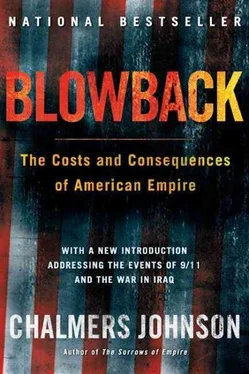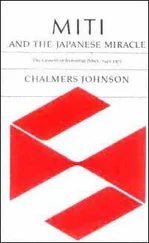Chalmers Johnson - Blowback, Second Edition - The Costs and Consequences of American Empire
Здесь есть возможность читать онлайн «Chalmers Johnson - Blowback, Second Edition - The Costs and Consequences of American Empire» весь текст электронной книги совершенно бесплатно (целиком полную версию без сокращений). В некоторых случаях можно слушать аудио, скачать через торрент в формате fb2 и присутствует краткое содержание. Год выпуска: 0101, ISBN: 0101, Издательство: Macmillan, Жанр: Старинная литература, на английском языке. Описание произведения, (предисловие) а так же отзывы посетителей доступны на портале библиотеки ЛибКат.
- Название:Blowback, Second Edition: The Costs and Consequences of American Empire
- Автор:
- Издательство:Macmillan
- Жанр:
- Год:0101
- ISBN:9780805075595
- Рейтинг книги:5 / 5. Голосов: 1
-
Избранное:Добавить в избранное
- Отзывы:
-
Ваша оценка:
- 100
- 1
- 2
- 3
- 4
- 5
Blowback, Second Edition: The Costs and Consequences of American Empire: краткое содержание, описание и аннотация
Предлагаем к чтению аннотацию, описание, краткое содержание или предисловие (зависит от того, что написал сам автор книги «Blowback, Second Edition: The Costs and Consequences of American Empire»). Если вы не нашли необходимую информацию о книге — напишите в комментариях, мы постараемся отыскать её.
Blowback, Second Edition: The Costs and Consequences of American Empire — читать онлайн бесплатно полную книгу (весь текст) целиком
Ниже представлен текст книги, разбитый по страницам. Система сохранения места последней прочитанной страницы, позволяет с удобством читать онлайн бесплатно книгу «Blowback, Second Edition: The Costs and Consequences of American Empire», без необходимости каждый раз заново искать на чём Вы остановились. Поставьте закладку, и сможете в любой момент перейти на страницу, на которой закончили чтение.
Интервал:
Закладка:
As the economist and editor of the Ryukyuanist , Koji Taira, observes, “According to the best estimates, the incomes generated directly or indirectly by the bases are only 5 percent of the gross domestic product of Okinawa. This is far too small a contribution for an establishment sitting on 20 percent of Okinawa’s land. Given the choice locations of the bases, if these areas were used as part of the civilian market economy, they should yield more than 20 percent of Okinawa’s GDP [gross domestic product]. In effect, the U.S. and Japan are forcing on Okinawa’s economy a deadweight loss of 15 percent of its GDP every year. In a democracy, such an abuse of the state’s taxing power should never be tolerated.” 25According to the Nikkei Weekly , a Japanese business newspaper, the aggregate income from the bases, including off-base consumption by American military personnel, the salaries of the approximately eight thousand Okinawans working on the bases, and rents paid to Okinawan landowners by the Japanese government for the land on which the bases sit, totaled ¥162 billion in fiscal year 1994, or 4.9 percent of gross prefectural income. 26
Most of the acreage on the mainland used for American bases is owned by the Japanese government and housed Imperial Japanese military installations up until 1945. In Okinawa, virtually all the land occupied by bases was seized from private owners either at the time of the Battle of Okinawa or during the 1950s. As former governor of Okinawa Prefecture, Masahide Ota, an authority on the island’s postwar history, testified in a base lands case before the Fukuoka High Court on December 22, 1995: “Just after the Battle of Okinawa, while forcibly confining survivors in concentration camps, they [the American military] immediately enclosed all the land and picked up land for military use to the extent they wanted for ensuring U.S. military purposes. It was done as if drawing lines on a blank map. When residents were allowed to come home from the camps, they found their hometowns had disappeared behind barbed wire.” 27
This process of seizure at bayonet point followed by the burning and bulldozing of houses and cultivated fields continued throughout the 1950s. Okinawan objections to American arbitrariness and unwillingness to pay appropriate compensation led to the first demonstrations against the U.S. presence and to the election in 1956 of a Communist mayor of Naha. The Americans thereupon rescinded the law under which the mayor had been elected, stripped him of office, and used the Central Intelligence Agency to funnel money to his conservative opponents.
The protest movement that lasted from 1952 to 1957 was the first of three major waves of protest focusing on bringing democracy to Okinawa. Its issues were the right to freedom of speech for Okinawans, unionization, proper compensation for expropriated lands, and popular election of a chief executive. The second wave crested at the end of the 1960s; its issues were the use of B-52s based in Okinawa to bomb Vietnam and the impact of the segregated military whorehouses that served the black and white G.I.s, near Kadena Air Force Base. This movement resulted in the reversion of Okinawa to Japanese sovereignty. The third wave, which arose in the wake of the 1995 rape case, still continues. Although none of these can claim to have produced victory—which by definition will not be achieved until the last base has been shut down—they have given Okinawa a special political culture. Unlike the main islands, where after the war the Allied occupation bestowed democracy and a “peace constitution” on the people from above, Okinawa is the only Japanese community whose residents have fought for what democracy they enjoy.
In the 1950s, one of the least-known American tactics for seizing land while controlling the rebellious sentiments of expropriated farmers was to offer them land in Bolivia and aid in emigrating. On arrival in Bolivia, however, the Okinawan farmers discovered that the land was nearly unusable jungle and the Americans had no intention of delivering any of the promised financial assistance. As neither American nor Japanese citizens, they had no place to turn for help and so were at the mercy of the terrain, the climate, and their Bolivian neighbors. Most of the early settlers died of disease or fled to Bolivian towns, to Peru or Brazil. The few who survived at Colonia Okinawa, as it was called, north of Santa Cruz, Bolivia, are today, after almost unbelievably difficult lives, comparatively successful farmers. However, of some 3,218 identified emigrants whom the Americans shipped to Bolivia between 1954 and 1964, only 806 (including their offspring) reside there today. 28
Most of the land that the Americans occupy in Okinawa is still legally owned by 31,521 individuals or families who are forced by various laws to lease it to the Japanese government, which, in turn, subleases it to the Americans without charge. These leases must periodically be renewed. In 1991, newly elected Governor Ota exercised the power given to him under the forced leasing laws to renew some 2,636 leases that had expired. This was, he has explained, the “most difficult decision of my life”—the ruling Liberal Democratic Party had made economic support for Okinawa contingent on preservation of the bases. 29In late 1995, with the movement inspired by the rape already growing, he refused to renew any more expired leases, forcing Prime Minister Hashimoto to play a politically unattractive role as lackey to the Pentagon. He had to renew the leases himself.
A sizable number of small landholders have become explicit and outspoken antiwar landlords, including some three thousand Okinawan and mainland intellectuals who have bought handkerchief-sized parcels of base land in order to protest the continued American presence. They are known as the one- tsubo landlords—a tsubo being a measure equal to 3.3 square meters—and have proved a severe thorn in Tokyo’s side. In May 1997, as the leases of many of the one-tsubo landlords came up for renewal, it became clear that the prefectural government would not save Tokyo’s face by forcibly renewing them. Prime Minister Hashimoto therefore introduced and guided through the Diet legislation that transferred all control over leases for base land to the central government. This law is almost surely unconstitutional on several grounds—it deprives Japanese citizens of their property rights without due process of law and it applies to only one place, Okinawa, although Article 95 of the Constitution stipulates that no law can deal with a particular area without its people’s consent.
The most famous of the Okinawan antiwar landlords is Shoichi Chibana. In 1945, his grandfather, armed only with a bamboo pole, attempted to protect his land from seizure and was shot to death. This land, in American hands ever since, is today on the site of the Sobe Communications Facility, one of numerous American installations in Okinawa for eavesdropping on the conversations of the surrounding nations, including Japan, and for communicating with U.S. submarines. In the spring of 1996, the lease on that land expired and Chibana refused to renew it. As a result, until the enactment of Hashimoto’s law a year later, the Americans were illegally occupying Chibana’s land. Much to the irritation of the American and Japanese governments, the Okinawan police forced the Americans to open their gates to Chibana and let him visit his land. On May 14, 1996, he and twenty-nine friends legally entered the Sobe Communications Facility, held a picnic on the lawn, sang Okinawan songs, and conducted a memorial service for his grandfather and father. The Japanese government will go to almost any lengths to avoid a repetition of this widely reported and photographed event.
One of the lengths to which it will go is to spend large amounts of public money to cover the costs of the bases, thereby turning the Pentagon into a central component of the Japan lobby in Washington, D.C. Japan is not obligated by any treaty to do this. The Status of Forces Agreement clearly states that “the United States will bear without cost to Japan all expenditures incident to the maintenance of the United States forces in Japan” except for the “construction of facilities.” But in May 1978, Shin Kanemaru, then chief of the Japanese Defense Agency and one of the legendary power brokers of the Liberal Democratic Party, arranged for Japan to donate ¥6.2 billion toward support of the U.S. forces. Kanemaru dubbed this the omoiyari yosan , or “sympathy budget,” because the American government had said to Tokyo that it was experiencing budgetary difficulties following the Vietnam War and could not cover all the costs of its bases in Japan. Initially the omoiyari yosan covered only the medical insurance of Japanese civilians working on the bases, but the Americans have asked for an increase in the sympathy budget every year since, and by 1997 it was ¥273.7 billion ($2.36 billion), more than forty-four times larger than the original sum.
Читать дальшеИнтервал:
Закладка:
Похожие книги на «Blowback, Second Edition: The Costs and Consequences of American Empire»
Представляем Вашему вниманию похожие книги на «Blowback, Second Edition: The Costs and Consequences of American Empire» списком для выбора. Мы отобрали схожую по названию и смыслу литературу в надежде предоставить читателям больше вариантов отыскать новые, интересные, ещё непрочитанные произведения.
Обсуждение, отзывы о книге «Blowback, Second Edition: The Costs and Consequences of American Empire» и просто собственные мнения читателей. Оставьте ваши комментарии, напишите, что Вы думаете о произведении, его смысле или главных героях. Укажите что конкретно понравилось, а что нет, и почему Вы так считаете.










